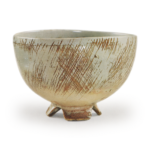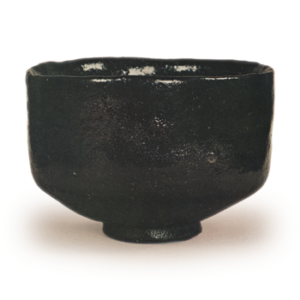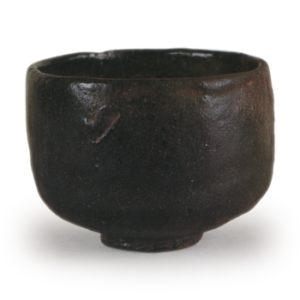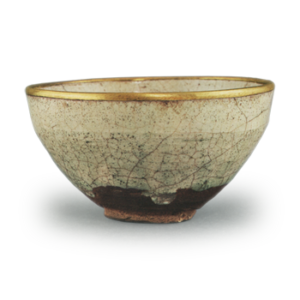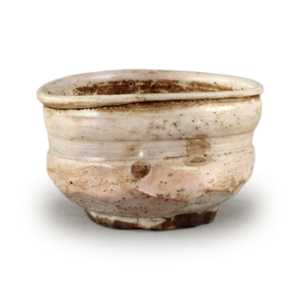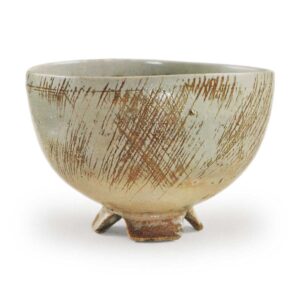
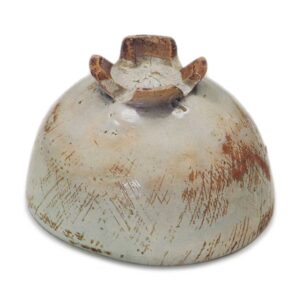
Height: 8.6-9.2cm
Diameter: 10.8-13.2cm
Height of foot ring: 5.9-6.0cm
Height of foot ring: 1.5-1.7cm
This is a rather small and thinly made elegant Kinkai. It is not marked with a signature. The entire outer surface is covered with fine diagonal lines, a technique known as “neko-kaki” (cat scratching), and it has been said since ancient times that “a thinly made neko-kaki hand is a sign of the times” or “a hand with neko-kaki all over it is a sign of a piece that is one step behind the times”. The Taisho Meiki Kan (Great Taisho Era Vessel Catalogue) also states that this type of vessel is a new style of kinkai. If we compare it with the Fujinami, which is also considered to be a Kin-kai, it is clear that this piece was made with the tea master in mind, and there is a clear difference in age. It also seems to be slightly different from the Saiobo, and probably the order of these pieces would be Fujinami, Saiobo, and then Kin-kai, but there is not thought to be such a large difference in age between the Saiobo and this piece. Rather, the difference in the intentionality of the work itself should be seen as being greater, more suited to tea ceremony connoisseurs.
The body is a hard, white porcelain with fine grains of sand dotted throughout, and also contains a small amount of iron. The foot ring is a light yellowish-white with a faint reddish tinge. The overall appearance is thin, clean and uncluttered, with a light appearance. However, the rim is distorted into a round shape, and there are dimples on two sides, like dimples. The foot is a rare form with a cross-shaped foot and four feet that open like petals, and the inside of the foot is also glazed, with creases in the surface of the silk crepe, centered on the helmet. It is a so-called oval shape, with a split foot ring and a hand that is covered in cat scratches. The thin construction makes the whole piece look a little delicate, but the sharpness of the solid blade can be seen in the foot ring, and the core is stronger than you might expect. The glaze is thinly applied to the entire surface, and the light blue-white color gives it a bright feeling. There are also reddish and yellowish spots dotted around the inside and waist.
The most striking feature of this teacup is the bundle of diagonal lines that cover almost the entire outside surface. These lines look as if they have been scratched on after glazing, but in fact it is thought that they were made by lightly scraping the surface with a stiff, rough brush-like tool while the clay was still soft immediately after being formed on the potter’s wheel, and then glazing the surface. Because the glaze layer is thin, most of the incised lines are barely covered by the glaze, and later tea stains and other substances adhere to these areas, creating a dark streaked pattern. We don’t know what tool was used to scratch the surface, but the fine, soft diagonal lines cross each other at just the right angles to create a rough or dense pattern that gives the impression of a naturally stylish kasuri pattern. This technique is extremely rare, and is almost never seen in other kilns, so it can be said that it is unique to Kinkai. A similar Kinkai teacup is held in the collection of the Fujita Museum of Art. This one has a different and interesting feel to it, with the cat scratches being roughly and widely drawn in a W-shape. There is also another example in which the entire outer surface is covered with vertical lines, creating a dense pattern similar to a bamboo blind. Of these, the tea bowl shown here is the most elegant and flawless.
The one that was handed down in Omi Otsu’s Kagi Go is recorded in the Taisho Meiki Kan as being in the collection of Mr. Matsuoka Tadayoshi of Kanazawa, but it is now in the collection of a certain family in Kyoto.

